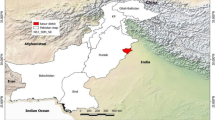Abstract
Five primate species were observed in an 83 hectare study site in northern Colombia. They wereAlouatta seniculus, Aotus trivirgatus, Ateles belzebuth hybridus, Cebus albifrons, andSaguinus leucopus. Average group size for the four diurnal species ranged from 5.3 individuals per sighting forCebus to 3.3 forAlouatta andAteles. BecauseCebus utilized regenerating forest, mature stands as well as cultivated sectors, they were able to use 30% more of the study site than the larger cebids. Monkey sightings along transects peaked at 0600–0800 and 1500–1800 and were lowest between 0900–1300 for the four diurnal cebids. The hourly rate of sighting the large cebids was 2–3 times greater for the point method than the transect method, but was less forCebus andSaguinus. However, consistently higher crude density estimates were obtained by the transect method than by the point method. As expected, there was less discrepancy between census methods for the large cebids which regularly utilized the upper canopy. The point method was barely 20% as effective as the transect method for estimating crude densities ofCebus andSaguinus. Factors influencing the effectiveness of the two census techniques as monkey detection and visibility, climatic conditions, and length of study are discussed. Recommendations for improving censusing effectiveness are listed.
Similar content being viewed by others
References
Baldwin, J. D. &J. I. Baldwin, 1974. Population density and use of space in howling monkeys (Alouatta villosa) in southwestern Panama.Primates, 13: 371–379.
Carpenter, C. R., 1934. A field study of the behavior and social relations of howling monkeys (Alouatta palliata).Comp. Psych. Monographs, 10: 1–168.
Chivers, D. J., 1969. On the daily behaviour and spacing of the howling monkey groups.Folia primat., 10: 48–102.
Coelho, A. M., Jr., C. A. Bramblett, L. B. Quick, &S. S. Bramblett, 1976. Resource availability and population density in primates: A socio-bioenergetic analysis of the energy budgets of Guatemalan Howler and Spider monkeys.Primates, 17: 63–80.
Dawson, G., 1978. Troop size, composition and instability in the Panamanian tamarin (S. oedipus geoffroyi): Ecological and behavioral implications. In:The Biology and Conservation of the Callitrichidae,D. G. Kleiman (ed.), Smithsonian Press, Washington, D.C., pp. 23–38.
Freese, C., 1975. A census of non-human primates in Peru. In:Primate Censusing Studies in Peru and Colombia. PAHO pp. 17–42.
Glander, K. E., 1975. Habitat and resource utilization: An ecological view of social organization in mantled howling monkeys. Ph.D. Thesis, University of Chicago, Illinois.
Green, K. M., 1975. The non-human primate trade in Colombia. In:Neotropical Primates: Field Studies and Conservation,R. W. Thorington,Jr. &P. G. Heltne (eds.), National Academy of Sciences, Washington, D. C., pp. 85–98.
Hernandez-Camacho, J. &R. W. Cooper, 1975. The nonhuman primates of Colombia. In:Neotropical Primates: Field Studies and Conservation,R. W. Thorington,Jr. &P. G. Heltne (eds.), National Academy of Sciences, Washington, D. C., pp. 35–69.
Instituto Geografico “Agustin Codazzi,” 1967. Mapa general de Bosques, Vol. 3, No. 2. Departamento Agrologico, Bogota, D. E.
Klein, L., 1972. The ecology and social organization of the spider monkey,Ateles belzebuth. Unpublished Ph.D. Thesis, University of California, Berkeley.
————, 1975. Social and ecological contrasts between four taxa of neotropical primates (Ateles belzebuth, Alouatta seniculus, Saimiri sciureus, Cebus apella). In:Socioecology and Psychology of Primates,R. H. Tuttle (ed.), Mouton Publishers, The Hague, pp. 59–85.
Muckenhirn, N. A., B. K. Mortensen, S. Vessy, C. E. O. Fraser, & B. Singh, 1975. Report on a primate survey in Guyana, PAHO, 49pp.
Neville, M. K., 1972. The population structure of red howler monkeys (Alouatta seniculus) in Trinidad and Venezuela.Folia primat., 17: 56–86.
————, 1974. Censusing primate populations in the reserved area of the Pacaya and Saimiria Rivers, Department Loreto, Peru. Manuscript.
Neyman, P., 1978. The ecology and social behavior of the cottontop tamarin in Colombia. In:The Biology and Conservation of the Callitrichidae,D. G. Kleiman (ed.), Smithsonian Press, Washington, D. C., pp. 39–72.
Pope, B. L., 1966. Population characteristics of howler monkeys (Alouatta caraya) in northern Argentina.Amer. J. Phys. Anthrop., 24: 361–370.
Struhsaker, T. T., 1974. A survey of the primates in the vicinity of Cubana El Duda, Parque Nacional La Macarena, Colombia. Manuscript.
----,K. Glander, H. Chirivi, & N. J. Scott, 1975. A survey of primates and their habitats in northern Colombia. In:Primate Censusing Studies In Peru and Colombia, PAHO Report, pp. 43–79.
Woodring, W. P., 1958. Geology of Barro Colorado Island, Canal Zone.Smithsonian Misc. Colls., 135: 39.
Author information
Authors and Affiliations
About this article
Cite this article
Green, K.M. Primate censusing in northern Colombia: A comparison of two techniques. Primates 19, 537–550 (1978). https://doi.org/10.1007/BF02373315
Received:
Accepted:
Issue Date:
DOI: https://doi.org/10.1007/BF02373315




